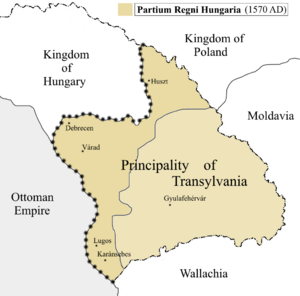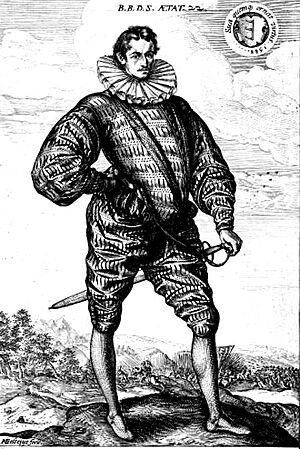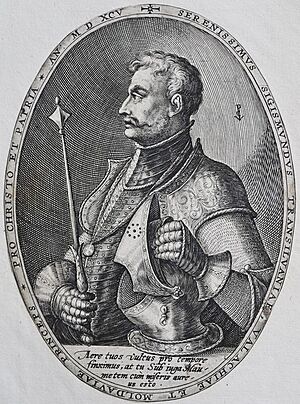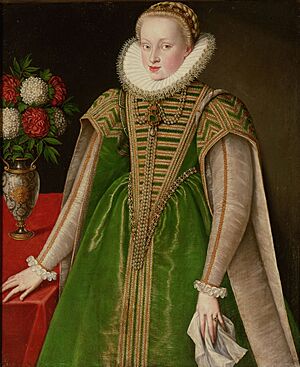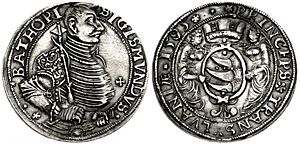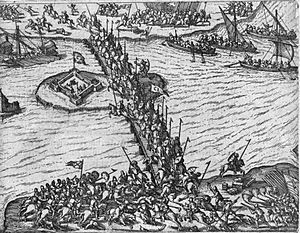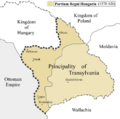Sigismund Báthory facts for kids
Quick facts for kids Sigismund Báthory |
|
|---|---|
| Prince of Transylvania, Wallachia, and Moldavia, Prince of the Holy Roman Empire, Count of the Székelys and Lord of Parts of the Kingdom of Hungary | |
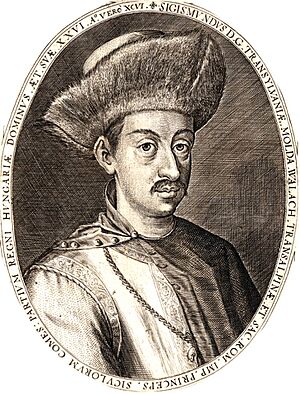
Portrait by Dominicus Custos
|
|
| Prince of Transylvania | |
| Reign | 1586–1598 |
| Predecessor | Stephen Báthory |
| Regent | János Ghyczy |
| Duke of Racibórz and Opole | |
| Reign | 1598 |
| Prince of Transylvania | |
| Reign | 1598–1599 |
| Predecessor | Michael the Brave (de facto) |
| Successor | Andrew Báthory |
| Prince of Transylvania | |
| Reign | 1601–1602 |
| Predecessor | Michael the Brave (de facto) |
| Born | 1573 Várad, Principality of Transylvania (now Oradea, Romania) |
| Died | 27 March 1613 (aged 39–40) Libochovice, Kingdom of Bohemia |
| Burial | St. Vitus Cathedral, Prague, Kingdom of Bohemia |
| Spouse | Maria Christina of Habsburg |
| House | Báthory family |
| Father | Christopher Báthory |
| Mother | Elisabeth Bocskai |
| Religion | Roman Catholic |
Sigismund Báthory (born in 1573, died on March 27, 1613) was a powerful ruler in a region called Transylvania. He was the Prince of Transylvania many times between 1586 and 1602. He also held the title of Duke of Racibórz and Opole in Silesia for a short time in 1598.
Sigismund's father, Christopher Báthory, ruled Transylvania before him as a "voivode," which means a military leader or governor. Sigismund was still a child when he was chosen to be voivode in 1581, after his father became very ill. At first, a group of advisors helped him rule. Later, János Ghyczy became his main helper. When his uncle, Stephen Báthory, died, Sigismund took the title of Prince.
In 1588, Sigismund was old enough to rule on his own. He joined the Holy League to fight against the Ottoman Empire. He also married Maria Christina of Habsburg, who was a niece of the Holy Roman Emperor, Rudolph II. Leaders from nearby regions, like Michael the Brave of Wallachia and Ștefan Răzvan of Moldavia, accepted Sigismund as their ruler. Their armies won an important battle against the Ottomans at Giurgiu.
After some difficult times, Sigismund gave up his throne several times. He received other lands as a trade, but he often returned to Transylvania. He finally settled in Bohemia in 1602. He died there in 1613.
Contents
Early Life and Family
Sigismund Báthory was born in 1573 in Várad, which is now Oradea in Romania. His father was Christopher Báthory, and his mother was Elisabeth Bocskai. At the time of his birth, his uncle, Stephen Báthory, was the ruler of Transylvania.
When Stephen Báthory became the King of Poland, he made Sigismund's father the voivode of Transylvania. This meant his father was in charge while Stephen was away. Sigismund's father and uncle were Roman Catholic. His mother followed the Calvinist faith. Sigismund was very devoted to Catholicism from a young age. His mother passed away in 1581.
Becoming a Ruler
Young Voivode
After his mother died, Sigismund's father became very sick. His father asked the Diet of Transylvania (a special assembly of nobles) to choose Sigismund as the next voivode. They agreed in May 1581. Since Sigismund was still a child, a group of twelve noblemen helped him govern. His cousin, Dénes Csáky, and his uncle, Stephen Bocskai, led this group. Sigismund's father died shortly after.
The Ottoman Sultan, Murad III, approved Sigismund's election in July 1581. He reminded Sigismund that Transylvania had to pay a yearly tribute to the Ottomans. Some people tried to become ruler by offering more money to the Sultan. However, Stephen Báthory and the "Three Nations of Transylvania" (the main groups of people in Transylvania) stood firm. The Sultan eventually confirmed Sigismund's rule.
Stephen Báthory took care of Sigismund's education. He made sure Sigismund had Jesuit teachers. He also wanted Sigismund's friends to talk about foreign lands, wars, and hunting to prepare him for ruling. In 1585, Stephen Báthory chose János Ghyczy to be the main regent, or helper, for Sigismund.
Prince Under Guidance
When Stephen Báthory died in December 1586, Sigismund took the title of Prince of Transylvania. He was still young, so Ghyczy continued to guide him. Sigismund was considered for the throne of Poland, but he was not chosen.
Sigismund's cousins, Balthasar Báthory and Stephen Báthory, returned from Poland. Balthasar wanted to be more involved in the government. This created some tension with Ghyczy.
In October 1588, the Diet suggested that Sigismund could rule on his own if he sent the Jesuits away from Transylvania. He did not want to do this at first because his own confessor (a priest who hears confessions) was a Jesuit. However, his cousins convinced him to agree. In December 1588, the Diet declared Sigismund old enough to rule and ordered the Jesuits to leave.
Challenges and Changes
Sigismund took his oath as ruler on December 23, 1588. Because he had expelled the Jesuits, Pope Sixtus V temporarily removed him from the Catholic Church. However, this ban was lifted in 1590, and the Jesuits returned a year later.
Sigismund tried to make the Roman Catholic Church stronger by giving important jobs to Catholics. This made some of his Protestant subjects unhappy. He also brought Italian artists and advisors to his court, which some people criticized.
There were rumors of disagreements and plots. A conflict led to the death of Sigismund's secretary, Pál Gyulai, in 1592. In 1593, Sigismund ordered the execution of his former tutor, János Gálffy. Later that year, the Ottoman Sultan declared war on the Holy Roman Emperor. The Sultan also demanded more tribute from Transylvania.
Sigismund decided to join the Holy League against the Ottoman Empire. This was a group of Christian states formed by the Pope. However, the Diet of Transylvania did not want to go to war with the Ottomans. In July 1594, Sigismund gave up his throne. But army commanders, including his uncle Stephen Bocskai, convinced him to return. They also persuaded him to arrest and execute several noblemen who had opposed the war. Most of these noblemen were Protestants.
The Holy League Alliance
Sigismund officially joined the Holy League on October 5, 1594. He joined with Aaron the Tyrant, the ruler of Moldavia, and Michael the Brave, the ruler of Wallachia. Sigismund claimed to be the main ruler over Moldavia and Wallachia.
In January 1595, Sigismund's envoy, Stephen Bocskai, signed a treaty in Prague. This treaty confirmed Transylvania's place in the Holy League. It also said that if Sigismund's family line ended, Transylvania would rejoin the Hungarian Crown. The Diet of Transylvania approved this treaty.
In May 1595, the nobles of Wallachia recognized Sigismund as their ruler. Michael the Brave was not allowed to make alliances without Sigismund's approval. Sigismund then invaded Moldavia and made Ștefan Răzvan the new ruler, who swore loyalty to him. After this, Sigismund called himself "Prince of Transylvania, Wallachia and Moldavia." He married Maria Christina of Habsburg in August.
Ottoman forces invaded Wallachia, forcing Michael the Brave to retreat. Sigismund offered freedom to the Székely commoners (a group of people who had lost their freedom) if they joined his army. They agreed, and Sigismund led a counter-attack. The combined armies of Transylvania, Wallachia, and Moldavia defeated the Ottomans in the Battle of Giurgiu in October 1595. This victory helped keep the alliance strong.
However, the Diet of Transylvania refused to give the Székely warriors their freedom back. Sigismund traveled to Prague to meet Rudolph II. While he was away, Stephen Bocskai cruelly put down a Székely uprising in early 1596.
Rudolph II promised Sigismund more soldiers and money. Sigismund returned to Transylvania and tried to capture a fortress called Temesvár, but he had to stop when a large Ottoman army arrived. Later, Sigismund's army joined the royal army, but they were defeated by the Ottomans in the Battle of Mezőkeresztes in October.
Giving Up and Returning
Sigismund felt discouraged by his marriage problems and the defeats in the war. He offered to give up his throne to Rudolph II in January 1597. An agreement was signed in December 1597. Sigismund received two duchies in Silesia, Racibórz and Opole, and money each year. This agreement was kept secret for several months.
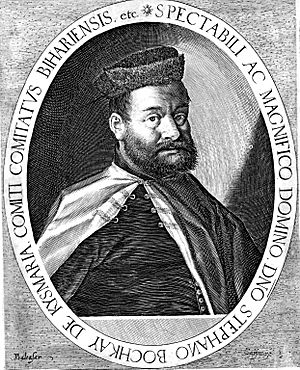

The Diet of Transylvania accepted Sigismund's decision in March 1598. Sigismund went to Silesia, but he did not like his new lands. His uncle, Stephen Bocskai, convinced him to return to Transylvania. Sigismund came back in August, and the Diet declared him prince again.
However, Sigismund could not make peace with the Ottoman Empire. He invited his cousin, Andrew Báthory, to return from Poland. In March 1599, Sigismund gave up his throne again, this time to Andrew Báthory. Sigismund then moved to Poland. His marriage was also declared invalid.
Andrew Báthory was later defeated and killed by Michael the Brave. Michael the Brave then ruled Transylvania for Rudolph II, but his rule was not popular. Sigismund announced he was ready to return in February 1600.
In March 1601, Sigismund returned to Transylvania with a Polish army. The Diet declared him prince again. However, Michael the Brave and another commander, Giorgio Basta, defeated Sigismund's army in August 1601. Sigismund fled but returned in September.
The Ottoman Sultan's representative confirmed Sigismund's position as Prince of Transylvania in October. Sigismund tried to take control of more areas but could not capture Kolozsvár. He began new talks with Basta about giving up his throne again. He left Transylvania for the last time in July 1602.
Later Life
After leaving Transylvania, Sigismund went to Prague to seek Rudolph II's favor. He received the right to own land in Bohemia in 1604. When Stephen Bocskai was proclaimed Prince of Transylvania in 1605, Rudolph tried to persuade Sigismund to return, but he refused. He also refused similar offers in 1606.
Sigismund received land in Libochovice, Bohemia. In 1610, he was accused of plotting against the emperor and was imprisoned for fourteen months in Prague. Sigismund died from a stroke in Libochovice on March 27, 1613. He was buried in St. Vitus Cathedral in Prague.
Images for kids
-
Sigismund's uncle, Stephen Bocskai, who encouraged him to return
-
A window in St Helena's Church, England, showing the coat of arms Sigismund Báthory gave to Sir John Smith.
See also
- List of rulers of Transylvania


